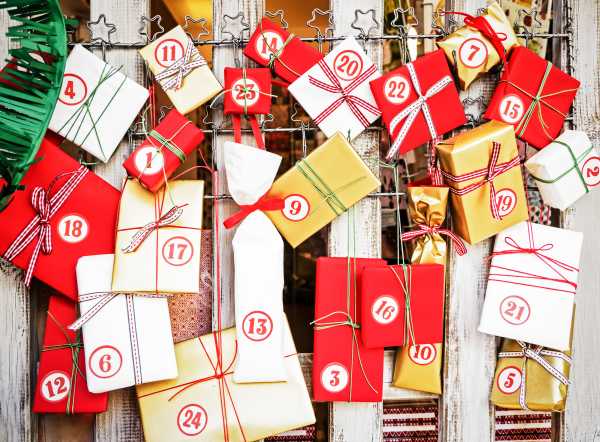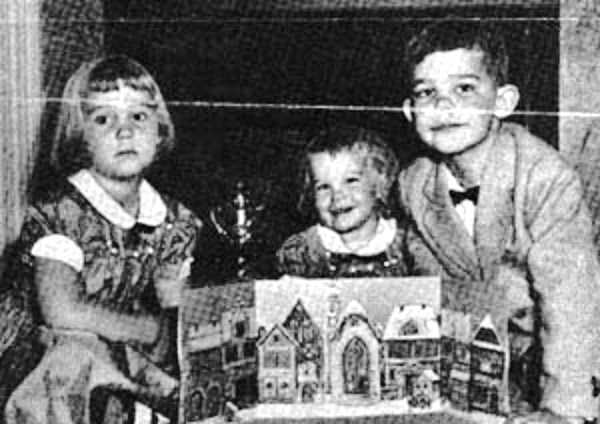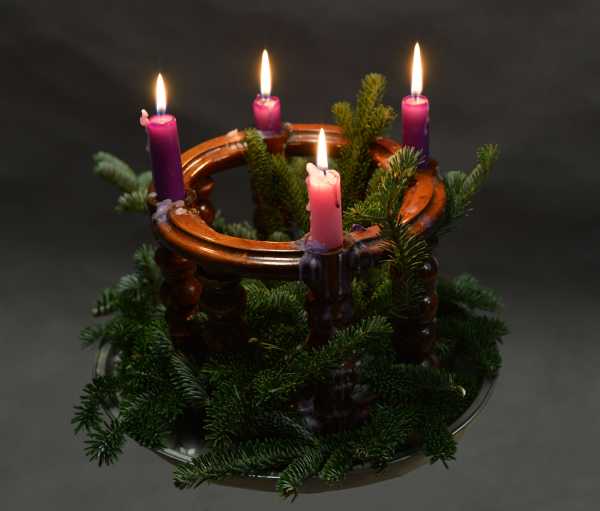
Most Christmas customs in the US share two characteristics. First, it’s usually hard to pin down their origins to a single source. And second, their roots almost always reach back to religious custom — Christmas being the second most important feast day (behind Easter) on the Christian calendar — but have since been adapted and, in some cases, scrubbed of religious content to make them more broadly palatable.
The celebration of Advent — whether with wreaths in church or calendars at home — is among these customs. On the one hand, it’s one of the major seasons celebrated by most Christian churches in the Western tradition: Roman Catholics, Anglicans, Episcopalians, Lutherans, and many additional Protestant churches mark the roughly month-long period with special observance.
But the word Advent comes from the Latin word for “arrival” — adventus — which means non-Christians can celebrate it simply as a fun countdown to Christmas. In that respect, it’s also become a marketing opportunity for retailers, mostly through Advent calendars, which have been around since the 19th century and have of late grown steadily more, shall we say, creative.
Most modern Advent calendars don’t technically cover the season of Advent
Most Advent calendars start on December 1. But the actual first day of the Advent season changes every year. In 2018, that day is December 2. In 2019, it will be December 1. The final day is the same every year: December 24, Christmas Eve — though many calendars run through Christmas Day.
The reason for the shifting start date is simpler than it appears. As celebrated by Christian churches in the Western tradition (as opposed to Eastern Orthodox churches, which keep a different calendar), the season of Advent begins on the fourth Sunday before Christmas and is celebrated on each successive Sunday leading up to Christmas.
There are always four Sundays in Advent prior to Christmas, but Christmas could be any day of the week — which means the distance between the fourth Sunday of Advent and Christmas Day varies. So the length of the season shifts from year to year: In 2016, Christmas fell on a Sunday, which means the season stretched over a total of 28 days. This year, the Advent season will be only 23 days long. In 2019, it will be 24 days long.
Advent calendars, though, are more consistent. They’re all set up for a 24- or 25-day season, beginning December 1 and ending on Christmas Eve or, sometimes, Christmas Day. The reason for this is practical: Since the length of the Advent season changes from year to year, it’s easier to pick a fixed number of days for a calendar that can be reproduced or reused every season.
And Advent calendars are reused all the time. When I was growing up, the Advent calendar in our house had a picture of Mary, Joseph, and the baby Jesus in the manger, with little windows that we opened and read aloud — each contained a verse from the Christmas story. Other people had Advent calendars that held a piece of chocolate to be eaten each day.

Since the mid-19th century, Advent calendars have morphed to fit their time
Advent calendars (in one form or another) were adapted some time in the 19th century by German Lutherans as a way to mark the days of the season leading up to Christmas. By the early 20th century, calendars were being manufactured and published in Germany, aimed at delighting kids during the holidays.
In a chilling development, when Nazi Germany attempted to change Christmas from a religious holiday to an occasion to praise the fatherland (Jesus’s Jewish origins being troublesome for Nazis’ racist ideology), it latched onto the Advent calendar as a way of inculcating loyalty into children. In 1943, a full-color calendar was produced by the Third Reich for distribution to German mothers; it included, among other things, designs that incorporated swastikas and other Nazi symbols. On one day, it has pictures that appear to tell the traditional Christmas story — Mary, Joseph, and the baby Jesus in the manger — but the story that accompanies the images is about a woodcutter, a soldier, and a king who get lost in the woods and encounter a woman with a baby who has wise words for them.
Following the war, with cardboard no longer rationed, Christian-themed Advent calendars made their way stateside thanks to the boom in production and the GIs who sent them home to their families. They got a boost in popularity when Newsweek published a photograph of President Dwight D. Eisenhower’s grandchildren with an Advent calendar in 1953:

Advent calendars have continued to be popular in the years since, often marketed with the suggestion that they help children count down the days to Christmas (presumably to keep them from bugging their parents every day about how many days are left until they can open presents).
The text accompanying the needlepoint Advent calendar sold by Lands’ End is typical of this marketing approach: “A little gift or treat every day can help kids get through the urgent days leading up to Christmas.” Pockets in the calendar can be filled by parents with toys or treats, small gifts to satiate the excited child. (One can detect some commonality between this and traditions around gift giving during Hanukkah.)
As such, Advent calendars aimed at children abound. Parents can help children put together a charm bracelet, or let them discover the art of Norman Rockwell. There are chocolate advent calendars in all shapes and sizes. There are calendars with puffy, soft shapes that slowly form a nativity scene or depict the adventures of Olaf from Frozen. There’s a popular Disney Tsum Tsum Advent calendar, a Lego Star Wars Advent calendar, and a Playmobil Advent Calendar. And, of course, a Disney Princess Advent calendar.
A specifically Christian variation called a “Jesse Tree” combines the Christmas tree with an Advent calendar, taking its cues from Isaiah 11:1, which many Christians take to be a prophecy about Jesus: “There shall come forth a shoot from the stump of Jesse, and a branch from his roots will bear fruit.” Jesse was the father of King David, who is said to be an ancestor of Jesus, and a tree depicting this lineage was often the subject of stained glass windows in churches. Ornaments with symbols that tell the Christmas story are placed on the tree each day until, by Christmas, it’s full. Participants can buy all kinds of Jesse Tree ornament sets, from rustic wooden ones to whimsical felt ones, or just make their own.
While Advent calendars were mainly used by religious families (and the Third Reich) for much of their history, today they’ve expanded to include non-ideological and adult audiences. Today, Advent calendars are available for virtually any taste, interest, or price point. Many Advent calendars serve as a way for brands to get 24 samples of their products into the hands of potential customers — not a bad marketing move in a month typically associated with spending money. If customers like the sample, the reasoning goes, then they’ll be inclined to buy the full-size version with their Christmas money. (This is in keeping with custom: The first chocolate Advent calendar was produced by Cadbury in 1958.)
Among the Advent calendars aimed and disposable-income-laden adults, there’s a calendar for Godiva chocolate, Diptyque scents, Ciaté London nail polish, and Revolution cosmetics. Or you can sample a variety of themed products: jerky, whisky, gin, scotch, rum, craft beer, cheese, sex toys, and beard oil.
Advent calendars don’t necessarily have to be physical objects, either. Music lovers can download a musical Advent calendar app from Naxos, and web design geeks can indulge in the digital 24 Ways Advent calendar, which dispenses design and coding advice over the 24 days leading up to Christmas. Some towns — like the English city of Henley-on-Thames — create living Advent calendars.
In a very cool custom I think the US ought to adopt immediately, some Nordic countries traditionally run an Advent television series, called a Julekalender, beginning on December 1 and running until Christmas Eve — think of it as a limited miniseries. The tradition started on radio in 1957 and first ran on Swedish television in 1960. Sometimes the show ties into a paper calendar that can be purchased in stores, and each day what’s behind the day’s calendar flap ties into the show. (An American radio show called The Cinnamon Bear was broadcast in the late 1930s and early 1940s, and was similarly arranged — six times a week from Thanksgiving to Christmas.)
But though Advent customs differ, they all circle back to adventus: the anticipation of something. Advent calendars are designed for anticipating the arrival of Christmas Day, in both its explicitly religious and more secularized versions.
The roots of Advent celebration, though, go further back than 19th-century Germany — stretching way back into the traditional Western Christian tradition, before Advent calendars were invented. That celebration has its own symbolism tied to the Christian calendar, and it’s still carried out in churches all over the world to this day.
Advent’s roots in Christian tradition persist to this day
Nobody seems to know precisely when the Western Christian church started marking Advent as a season on its calendar. But it seems to have popped up early in church history, and has stayed remarkably stable since about the Middle Ages.
The easiest way to understand the Christian church’s calendar is as a sort of live immersive theater, designed by tradition to reenact the life of Jesus every year from Christmas (birth) to Easter (resurrection), with readings in traditional churches that revisit stories from the gospels each year during that time. Advent — adventus — is the part of the calendar that’s all about anticipation. In Christian teaching, there are two events being anticipated.
Part of the observance of Advent, celebrated for the four Sundays before Christmas, is reenacting the centuries of anticipation of the birth of Jesus as written about by prophets like Isaiah in the Old Testament. Many songs traditionally sung during the season have lines recalling this waiting period, such as “O Holy Night” (“Long lay the world in sin and error pining / ’Til he appeared and the soul felt its worth”). That’s also why the early parts of Handel’s Messiah quote the prophet Isaiah before they get to the more familiar Christmas parts: The lyrics for “Comfort Ye My People” and “Every Valley Shall Be Exalted,” for instance, correspond directly to the readings from Isaiah 40 that a person might hear in a church pew during Advent.
But Christian theology also contains a belief that at the end of days, Jesus will return to set things right in the world, erasing death and suffering — a concept usually called the Second Coming. So in addition to being about the anticipation of Jesus’s birth (the first coming), Advent is also set aside as a time of quietness and austerity, meant to keep Christians from glossing over the brokenness of the world and to encourage them to anticipate the Second Coming.
“Joy to the World” — which, in traditional Christian practice, should only be sung at the conclusion of Advent — contains a verse summarizing this side of the celebration: “No more let sins and sorrows grow / Nor thorns infest the ground / He comes to make His blessings flow / Far as the curse is found.”
Religious observance of Advent comes with its own set of symbols
In churches that celebrate Advent, the most common factor across denominations is the Advent wreath, which was adopted around the Middle Ages. It’s like a normal Christmas wreath, but presented horizontally, often on a podium at the front of the church (though people often have them in their homes as well). There are typically candleholders for tapers in the wreath. The colors vary slightly from denomination to denomination, but the wreath always has four candles on it — typically three dark purple or blue, one rose-colored — and a white candle in the middle to light on Christmas Eve.

On each of the four Sundays of Advent, the candles are lit: one on the first Sunday, two on the second, and so on. If there’s a rose candle (which is meant to symbolize joy), it’s lit on the third Sunday, which is around the midpoint of Advent, a time to celebrate that the waiting is nearing its close.
In keeping with the theme of waiting and remembering, Advent is also traditionally marked with a fast, similar to the Lenten fast that many people (even those who are only marginally observant) practice during the 40 days before Easter. Advent is shorter than Lent, and the fast is less widely practiced, but generally people choose to give up something — a type of food, a practice or habit, and, lately, Facebook — in order to focus on prayer and preparation for the celebration of Christmas.
Additionally, some churches change the colors of the cloths and linens used in the sanctuary during Sunday services — often to purple. Churches hold off on singing jubilant Christmas songs, instead opting for Advent hymns, the most popular of which is probably “O Come, O Come, Emmanuel,” a translation of a Latin hymn. Some churches make a practice of giving away more money or participating in other community-wide practices during the season of Advent. (One newish one is the Advent Conspiracy, started by a loose affiliation of churches in 2006 to combat hyperconsumerism and help fund clean water initiatives.)
As with pretty much every Christmas custom, though, Advent doesn’t just belong to Christians who celebrate it — it’s been broadened to include everyone who takes part in the holiday, whatever meaning they take from it. Every Advent observance, regardless of whether it includes a religious element, touches on a need to have a bit of beauty each day during the season. And it’s all in anticipation of future joy.
Sourse: vox.com






